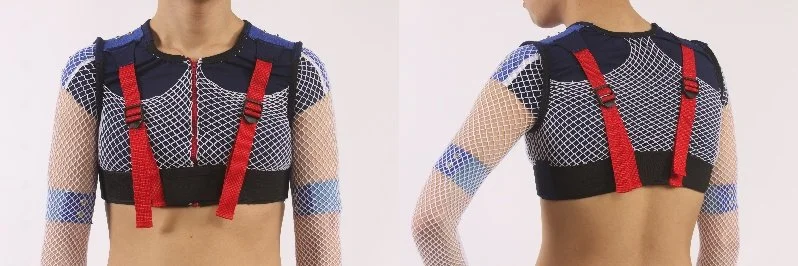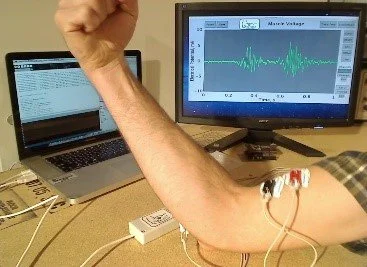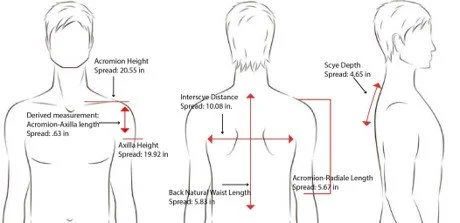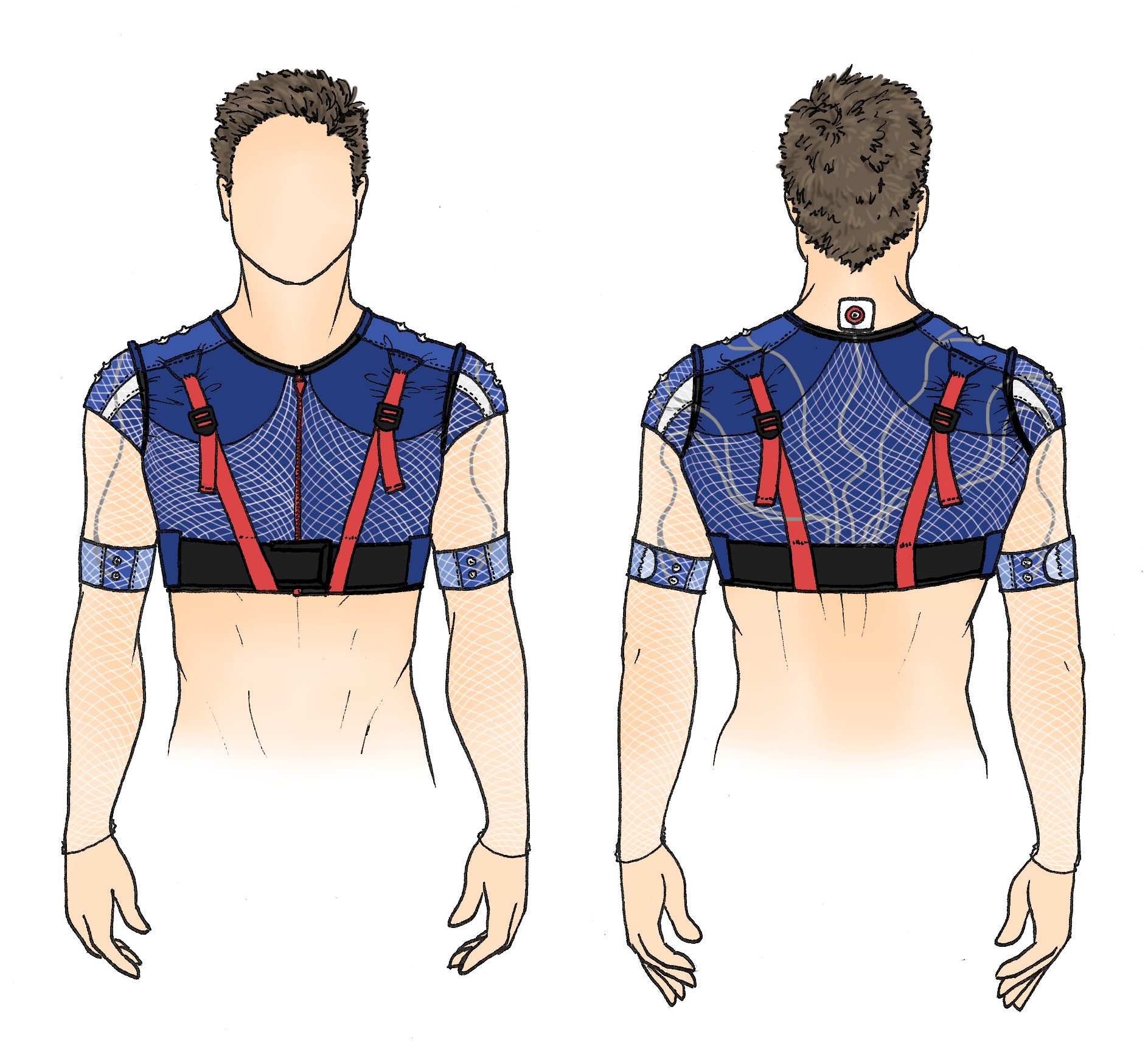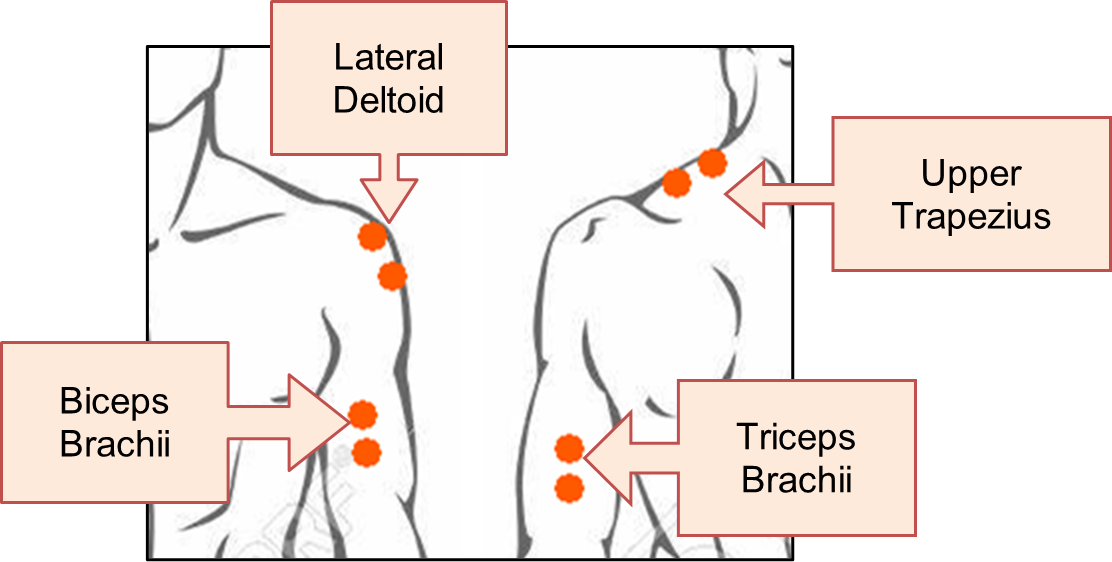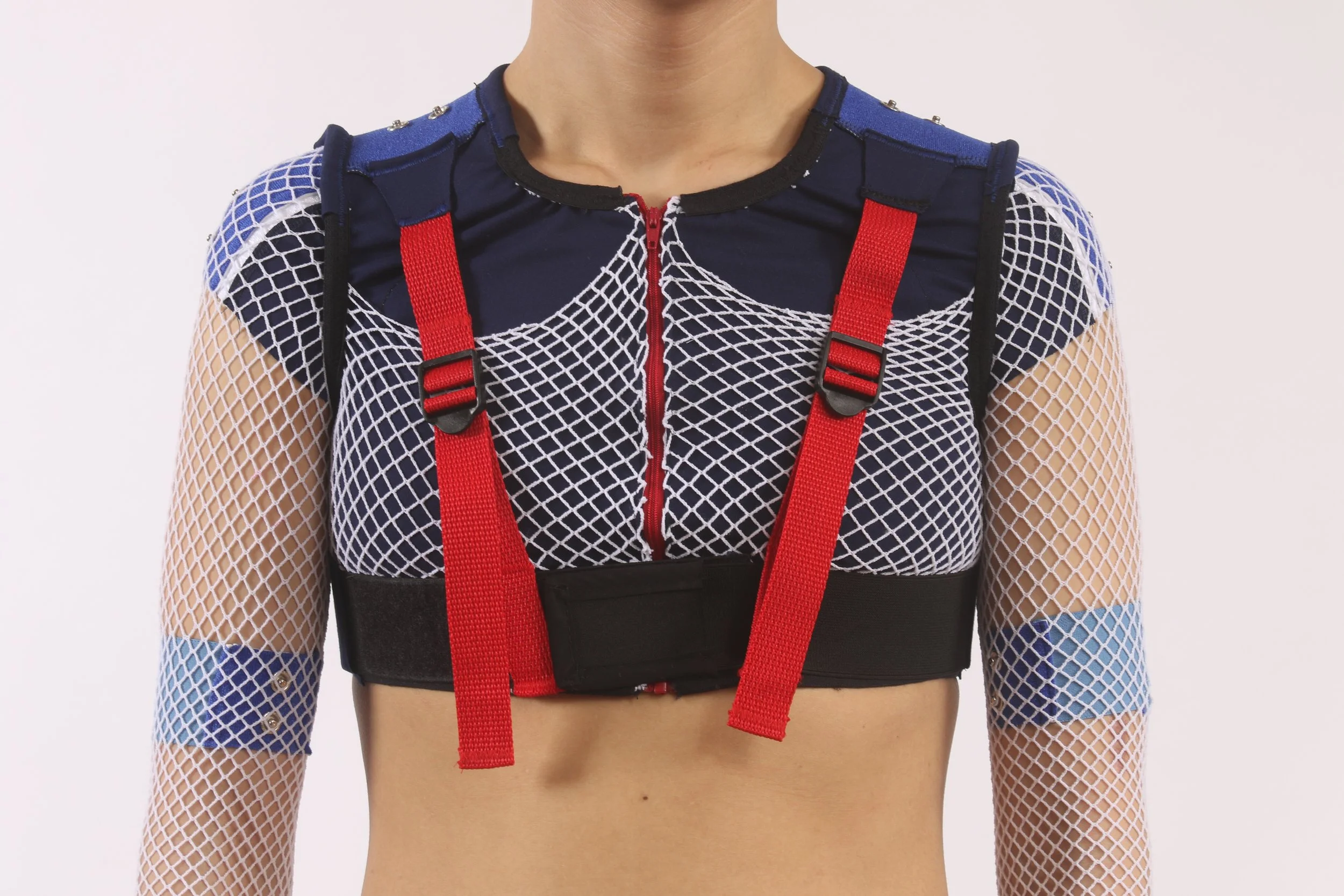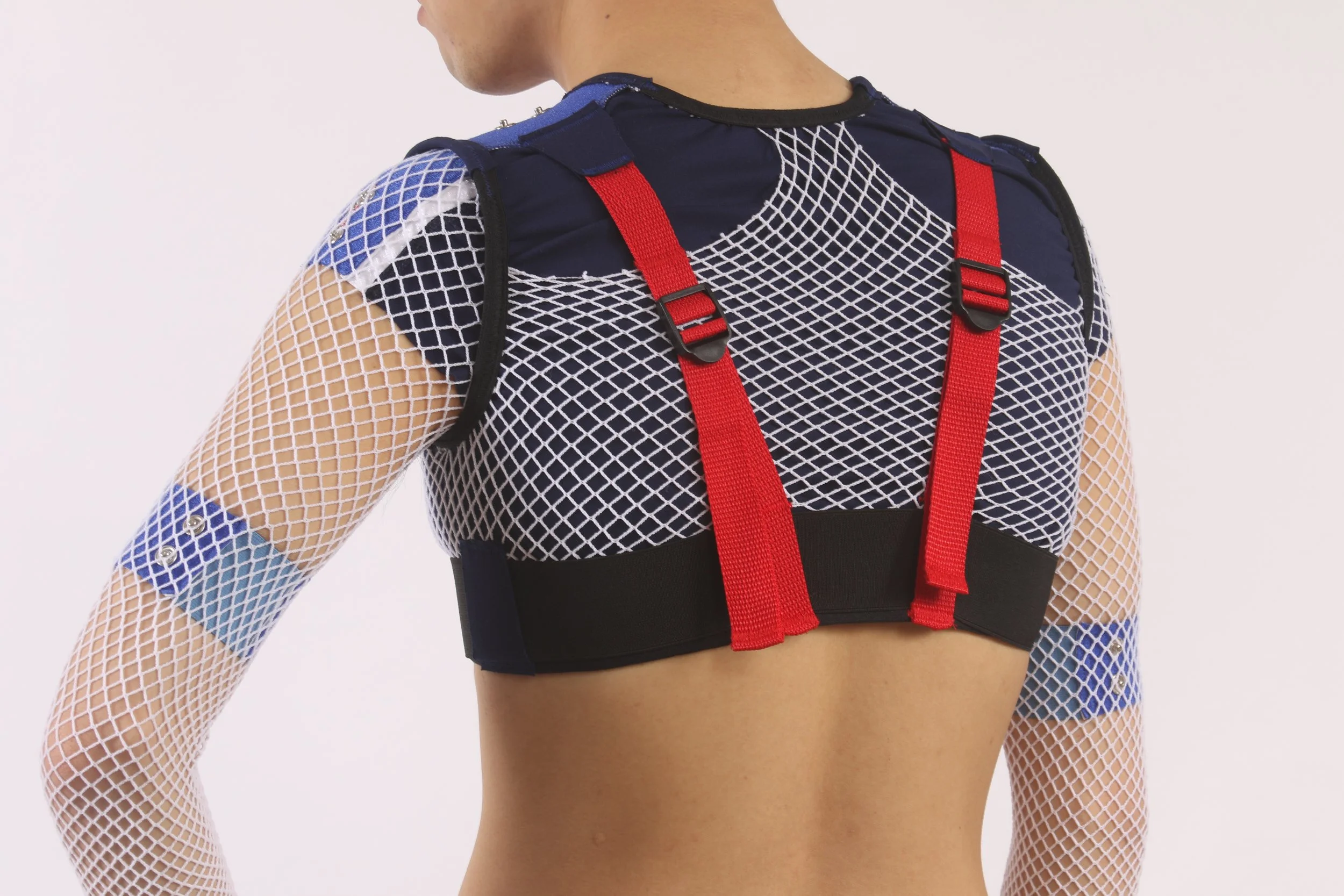Intra-spacesuit EMG Garment
Proof-of-concept wearable system for measuring upper-body muscle movements within a spacesuit for biomechanics research
I had the unique opportunity to design a wearable system for aerospace applications, when I took the Functional Clothing Design course at the University of Minnesota for my master’s degree. The extensive coursework was driven by a team project to provide a design solution for the real-life challenges faced by various industry sponsors of the Technology Collaborations Center (NASA-affiliated nonprofit). My team’s chosen challenge was to devise a feasible wearable system for studying biomechanics of suited astronauts.
In just one semester, we carried out an extensive background research of the problem scope, tested the effectiveness of various sensor components and wearable form factors, designed & constructed the final prototype, and conducted a human subject testing for proof-of-concept validation. As the project leader, I took charge of the pivotal aspects of the project that involve technical knowledge, such as managing data acquisition devices, running pilot tests on various design ideas, and analyzing on-body electromyographical (EMG) signals. Originally presented at NASA, this project later garnered recognition beyond the scope of the semester, winning awards and being featured in other venues.
Industry Sponsors (TCC workshop): KBRWyle / NASA
Timeline: Spring 2018
Platform: Physical garment prototype
Collaborators: Stephanie Wang & Caroline Albers
Professor/Advisor: Dr. Lucy Dunne
Watch the introduction video explaining this design (No sound)
Background & Motivation
Astronauts experience frequent musculoskeletal injuries, especially from performing body movements inside rigid spacesuits. To devise preventative strategies, there has been a great need to study the mechanisms of these injuries, but it has been generally difficult to record the exact body motions inside bulky spacesuits with conventional imaging methods.
Outside of imaging technologies, an alternative method called electromyography (EMG) allows direct measuring of muscle activations without having to visualize body movements and may hence contribute to a better understanding of the issue.
However, EMG is usually time-consuming to set up, often bulky and uncomfortable, or sometimes even invasive. Thus, our challenge in the project was to design a wearable system that could measure an astronaut’s muscle activities inside a rigid spacesuit in a comfortable, non-invasive way.
As upper-body injuries in the shoulder area tend to be most common and severe for suited astronauts, we also prioritized providing biomechanics measurement for the upper arms and shoulders.
Design Considerations & Requirements
We first carried out an extensive review of the scientific literature, focusing on the variables that influence the quality of EMG recordings and the unique logistical challenges for collecting EMG signals inside a spacesuit. It became clear that the interplay of myriad factors within the problem scope had to be considered for developing a successful EMG measurement solution for suited astronauts.
With this background research, we identified several requirements and factors that we needed to either satisfy or consider in our final design:
Electrode materials needed to be non-invasive and comfortable with long-term use and perspirations, while providing the good-quality signal in conjunction with the overall form factor.
Reliable mechanical coupling to prevent signal noise and motion artifact generally seen with loose skin-electrode contact.
A wearable form factor that allows for mobility with minimal shearing force on the electrodes to prevent motion artifact and signal noise.
Design needs to provide room for adjustability, as the precise locations for individual muscles may vary across populations.
Since adhesive electrodes are irritating to the skin and time-consuming to apply, we favored using reusable electrodes integrated into a garment with easy donning/doffing, for convenience and sustainability.
Iterative Design & Development Process
Example results during the iterative testing (Blue lines = true muscle activation signals; Orange lines = motion artifact from passive movements)
Choosing electrode materials
My main task during the process to find components and forms for the design, I tested about 18 different combinations of potential electrode materials (from conventional hydrogel electrodes to conductive textiles) to determine the ideal option of electrode material & coupling for our prototype that would provide good-quality signals while withstanding mobility. Interestingly, metal snaps were found to be a good electrode material when secured to the body with elastics, and this option was used in our design for ease of implementation.
Determining sizing and overall form factor
Based on our review of anthropometrics, we decided on using a scalable pattern to allow for a general sizing system, as well as using stretchy, form-fitting materials that would provide reliable on-body electrode coupling within the garment. We tested a few different candidates of stretchy wearable materials to provide the ‘base’ onto which the electrode would be attached; our pilot study of signal comparison found that the fishnet garment caused the fewer instances of motion artifact and better signal quality.
Integration of components and garment construction
After pilot-testing various materials and form factors, we underwent more hands-on, trial-and-error iterative development process as we began integrating these components into a form-fitted wearable system that enables reliable electrode-skin contact while allowing mobility. To ensure tight mechanical coupling, we further identified and integrated other elastic, nonslip materials such as ponte knit fabric and Fabrifoam® medical wraps in the garment construction. We also discovered ideal garment design & construction techniques that help keep the tension on the metal snap electrodes, via repeated ideations and ad-hoc testing.
Final Design & Features
Our final design afforded easy application with a front zipper (simple don/doff) and built-in electrodes on the appropriate muscle locations (reducing EMG setup effort). The garment was also designed to be washable as-is, affording sustainability and (re-)usability as opposed to the conventional method. The built-in electrodes for the biceps brachii, triceps brachii, lateral deltoid, and upper trapezius on both sides of the body allow simultaneous measuring of EMG for 8 upper body muscle locations for a holistic view of our target area.
The bodice made from structured ponte knit that maintains a sturdy shape, and the user can tighten the bodice further with an elastic waistband. Adjustable red straps allow the user to bring the embedded shoulder electrodes onto the skin. Fabrifoam nonslip medical wrap was incorporated at the shoulder, armband, and over the chest to prevent slippage. Despite its loose stretchy structure, fishnet has enough compression to keep the electrode cables in place, providing compatibility with conventional data acquisition devices.
Tight elastic bindings were used strategically on many seams to provide snug cinching of materials close to the body, while we avoided this technique intentionally on some edges to prevent sleeves from bunching or sliding up.
Using elastic belt around the ribcage and adjustable straps across the back and chest help to hold the upper trapezius electrodes against the skin even if the fabric around them bunches during arm movement
Human Subject Validation Testing
To validate our prototype, we conducted a human subject testing to compare EMG signals obtained from three conditions using:
conventional disposable electrodes
our garment w/ solid hydrogel between the skin and metal snaps
our garment as is (“dry”)
Results showed that EMG signal strength was mostly stable and equivalent among all conditions, with very little signal noise, even without any hydrogel application. (For deltoid muscles, dry metal snaps were even more sensitive with maximum peaks reached.)
Overall we found that the garment can be used to measure the presence, duration, and sequence of upper body muscle activations. The garment also proved to be convenient due to its ability to apply many electrodes at once, unlike the tedious one-by-one electrode application with taping the wires on the subject’s skin.
Awards & Recognition
My teammates and I showcased our final prototype at the annual Wearable Technologies Workshop held at NASA Johnson Space Center (Houston, TX) in April 2018.
Afterwards, our design went on to receiving further recognition from other venues, beyond the scope of the coursework.
Our design won the 1st place in the Advanced Textiles Student Design Competition held by Industrial Fabrics Association International (IFAI), also presented at 2018 IFAI Expo.
This garment was featured at the 2018 International Symposium on Wearable Computers (ISWC) and was awarded the Juried Design Exhibition Award in Functionality category.
In addition, I carried out another related project with my colleague (Alireza Golgouneh) looking into more rigorous validation of the EMG signal quality of the metal-snap electrodes, which was also published and presented at the 2019 International Conference on Environmental Systems (ICES).
In conclusion…
What I learned
Through extensive literature review and hands-on testing, I learned not only how to conduct and analyze EMG studies for biomechanics research but also process of solving unique interdisciplinary problems with a creative yet persistent mindset. By taking charge in areas that require more technical execution and logistic handholding as a team leader, I also learned how to best enable and utilize the expertise of my teammates, colleagues, and other mentors or stakeholders.
What was the most challenging thing about this project and how did you overcome it?
I was less than optimistic in the beginning of the project, tackling a topic of kinesiology that I was not familiar with, and more so upon learning that EMG signals are very finicky and difficult to collect and analyze. Being able to quickly and repeatedly pilot-test different ideas as we moved forward was a big reason for our success, since we could keep an agile pace to figure out what design feature works and discover creative solutions.
What part of the design process did you particularly enjoy?
It was extremely rewarding to work with talented and responsible teammates to come up with a design solution that initially seemed impossible, and the process of trying out different ideas and discovering elegant ways to make all components work together was a great collaborative experience.
